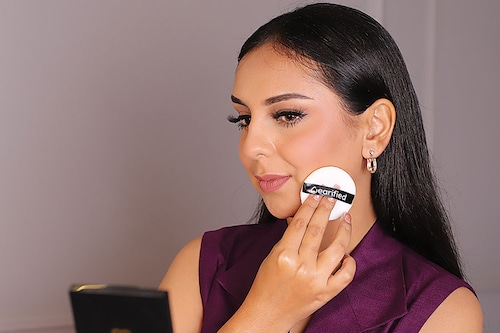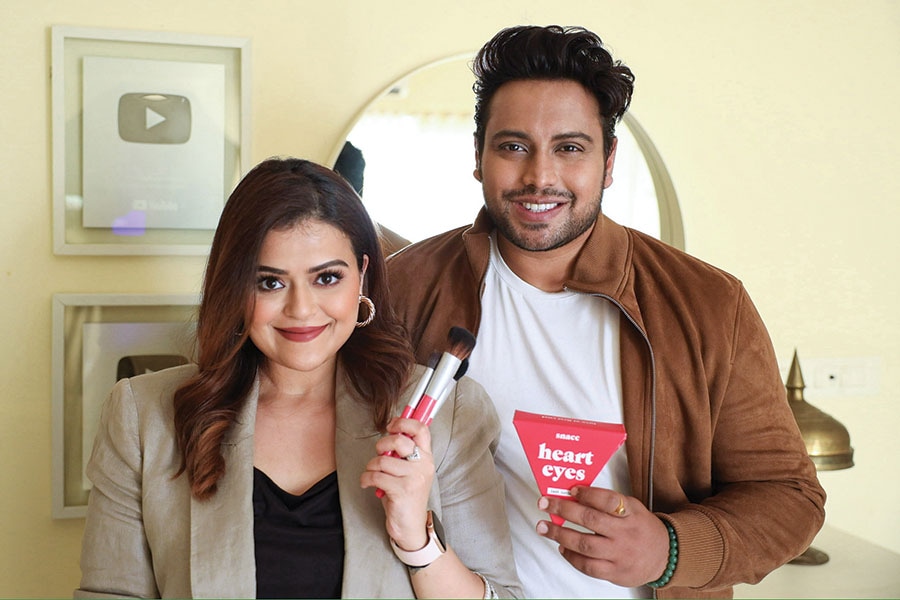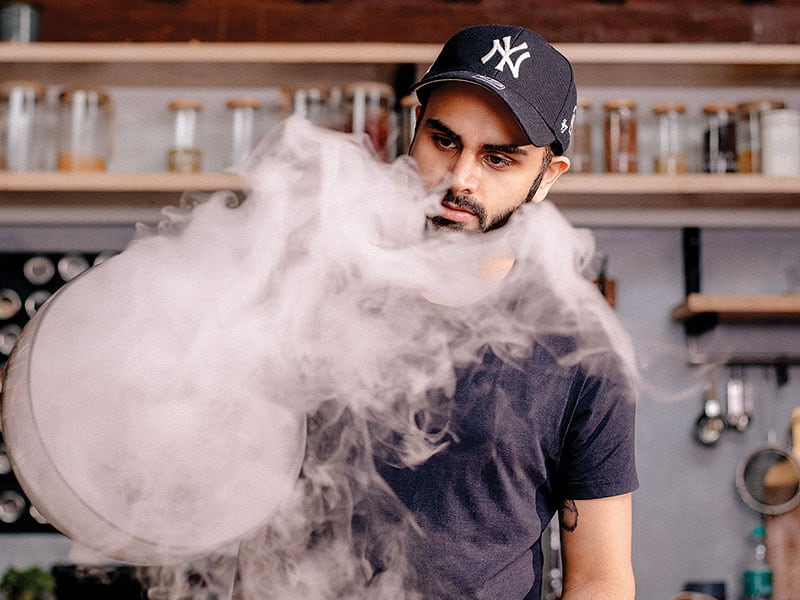From creator to entrepreneur: The evolution of social media influencers in India
A new generation of entrepreneurs—creator-founders—has emerged, launching its own D2C brands, and turning followers into customers


First, influencers get recognised by brands. Then, they become a brand themselves. And now, in the fast-paced world of content creation, these influencers, who once focussed on building a massive online following, are stepping into the entrepreneurial arena and building their brands, products and companies.
On a global scale, the influencer community has witnessed a surge, with an economic activity exceeding $15 billion, informs Raghav Anand, partner-digital media for Africa, India and the Middle East at EY India. And, within the Indian landscape, select short-video platforms have emerged as catalysts of substantial social impact, driving an economic value that is estimated to be valued at $6 billion by 2030, he says.
“The influence exerted by the creator economy is estimated to be three to four times the officially reported figures," says Anand. “With influencers establishing their brands, the horizon of socioeconomic impact is going to expand to include distributors, manufacturers, retailers, raw material providers, and an array of other stakeholders, thereby enlivening the entire ecosystem."
In addition to the social impact, stepping into business, from a creator’s point of view, is natural progression.
To make a decent revenue through advertising—their primary source of income—influencers have to scale to a certain threshold—a million or a million-plus followers.

“Those who are able to scale look for diversification of revenues, and those who do not, desperately try to get revenues," says Anand. So, the obvious channel of progression every influencer follows is starting with advertising to subscription to micro-transactions and lastly, ecommerce.
Agrees Apaksh Gupta, founder and CEO of influencer marketing platform One Impression. “I don’t see a creator not trying to diversify their monetisation opportunities. As people who’ve built themselves as a brand, creator-entrepreneurs is the way we are going to see this economy evolve," adds Gupta.
Take, for instance, Wearifed, an Indian beauty brand launched by influencer Aanam Chashmawala in October 2021. Ten years into the industry, covering beauty, lifestyle and fashion, Chashmawala felt the lack of inclusivity by beauty brands catering to Indian skin tones and types. “Having felt left out myself in my younger days, I would never want anybody to feel that way," says Chashmawala.
The thought of launching a brand was planted when she would often find herself mixing foundation and lipstick shades to match her tone and never found the right one. On one occasion, a brand sent her three of the darkest foundation shades, but again, those didn’t match.
“It reinforced my belief that I’m on the right track," she says. After setting aside funds she received from the monetisation of her content, and almost five years of research, it resulted in a brand aimed at promoting individuality.
Also read: Vani Murthy: Building a sustainable, low-waste army
But, like with anyone trying to start a business, even for creators like her who command over 500,000 followers across channels, the journey is challenging. “First, the perception of a content creator is that it’s not serious business. And the second, you’re a woman trying to be an entrepreneur," she adds.
Today, the brand has about 75 individual SKUs (stock keeping units) and is profitable, claims Chashmawala. “I haven’t had to put back any money into the business and have no plans to raise funds shortly."
As a creator, one has the unique advantage of knowing what’s happening inside the industry and also the opportunity to see what the audience wants. “For creators wanting to turn entrepreneurs, there’s scope for the long term because they have a follower base that trusts them, and that’s a huge return on investment," Chashmawala says.
 Shivangi Sharma and husband Arjun Sen have launched Snacc Cosmetics to be a one-stop solution for make-up tools.
Shivangi Sharma and husband Arjun Sen have launched Snacc Cosmetics to be a one-stop solution for make-up tools.
But this customer base is also dangerous. “You can’t be a credible content creator with a bad product," says Shivangi Sharma, a YouTuber and co-founder of Snacc Cosmetics.
While Sharma and her husband, Arjun Sengupta, have been creating content related to comedy, food, beauty and lifestyle since 2017, when YouTube was still up and coming, it was in 2018 that Sharma’s videos related to beauty and makeup started getting noticed.
During this journey, Sharma realised the dearth of quality and affordable makeup tools. Having run a business earlier, and learning from the mistakes made then, the couple launched Snacc Cosmetics in October 2022 as a one-stop solution for make-up tools. Today, they have 14 SKUs and an approximate revenue of Rs 14.7 lakh. They are also in the process of exploring other ecommerce platforms to list their products. “We are hoping to up the numbers in the next few months during the festive season and the New Year period," Sengupta says.
As creator-entrepreneurs, Sengupta says, they know their audience inside out. But, like with content creation, the key to keeping the business running and sustainable is to be consistent. “The audience is quick to point out mistakes with the product, and it’s worse when there’s a face of an influencer attached," Sengupta says.
 Chef Sanjyot Keer, who has over 13 million followers, recently launched kitchen and home appliances brand YFL Home in August.
Chef Sanjyot Keer, who has over 13 million followers, recently launched kitchen and home appliances brand YFL Home in August.
While building a direct-to-customer brand is completely different from building content, what’s common between the two is identifying a problem and solving it, feels chef Sanjyot Keer.
Mumbai-based Keer started cooking in grade six, studied hotel management, got roped in as a food producer for Masterchef India, and went on to launch a food-related YouTube channel, Your Food Lab, in 2016. Over seven years, he has created more than 3,000 simplified recipes and a community of over 13 million followers across channels.
Now to help people cook better at home, he launched YFL Home in August, a kitchen and home appliances brand, in partnership with House of X, founded by creator Raj Shamani. “I felt an amalgamation of technology and innovation in home appliances would create a better cooking experience for people at home and take them closer to restaurant-style food," says Keer.
With one product, a mixer grinder, out now, Keer is envisioning YFL Home to be a problem-solving company in the home and kitchen space.
“Making a video may take a couple of days, but building a brand is time-consuming. That’s the only difference and the biggest challenge I feel," he says. “I’m aware of the advantage I have from being a content creator and the impact it will have on the product, but ultimately the product will have to speak for itself, whether I have the backing from the channel or not," he adds.
 YouTuber Jyotii Sethi launched her sari brand Aabhaari, but unlike other creators, instead of going social-first, she chose to showcase the collection at exhibitions and then launched it online.
YouTuber Jyotii Sethi launched her sari brand Aabhaari, but unlike other creators, instead of going social-first, she chose to showcase the collection at exhibitions and then launched it online.
Fashion, beauty and lifestyle YouTuber Jyotii Sethi launched a sari brand called Aabhaari in August. But unlike other creators, instead of going social-first, she chose to showcase the collection at exhibitions and then launched it online. So far, Aabhaari has registered over 300 orders.
“I wanted to know the pulse of the customers by being on the ground, and then build a presence online. It was like challenging myself to see if there is potential beyond the existing subscriber base," Sethi says.
Although she had always wanted to run a business, now was the right time to jump into it and the most natural step after establishing herself as a creator, she feels. “YouTube taught me how to form a company, what is a GST number, and more. The rest, I’m learning on the job. There are mistakes, but they are a bittersweet feeling," she adds.
Sethi is certain that her hard work will pay off. “When an influencer has worked day and night towards creating a massive following, why not turn it into something more sustainable? Touching people’s hearts is a big achievement," she adds.

Creators embarking on a journey to launch their brands are proving that great businesses can be made on the community they have built, says Gupta. “It is definitely not a fad. As long as they introduce differentiated products, it’s like any traditional business trying to diversify revenue streams," he says.
The question is, will they be successful? There has been a remarkable surge of direct-to-consumer (D2C) brands in the recent past. However, even the few who attain considerable growth must grapple with a series of challenges. The costs associated with customer acquisition often prove to be exorbitant, the complex distribution systems present formidable obstacles, and the ongoing provision of a consistently superior customer experience, a feat that established corporate giants excel at, may be difficult for individual influencers to attain, feels Anand of EY India.
“There is still lack of infrastructure for creators to be able to create successful brands at scale," says Gupta of One Impression.
Those that manage to make a larger team or partner with a brand owner will be able to be more successful, the experts feel.
In that case, “If the question is, five years down the line, will we see more number of successful brands at scale by creators, I would say, the answer is yes," says Gupta.
View the full list of India"s Top 100 Digital Stars 2023 here.
First Published: Oct 31, 2023, 13:13
Subscribe Now